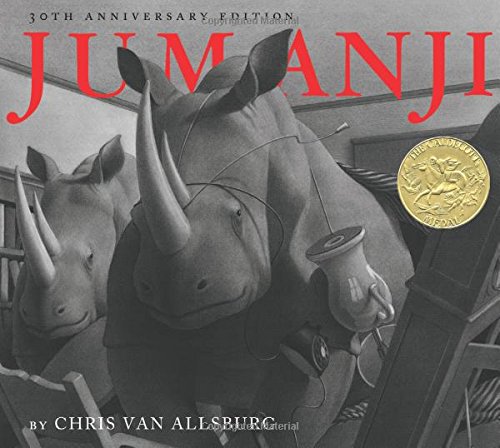Jumanji
by: Chris Van Allsburg
Second Grade

- APA Citation: Allsburg, C. V. (1988). Jumanji. New York: Scholastic.
- Description: When Judy and Peter find a board game in the park, they take it home, hoping to alleviate their boredom. One live lion, an erupting volcano, and a dozen destructive monkeys later, the children are no longer bored. Their jungle adventure game has come to life! Chris Van Allsburg is a master at walking the line between fantasy and reality. His unusually sculptured drawings (familiar to the many devoted fans of the Caldecott-winning The Polar Express and The Garden of Abdul Gasazi) convey the magical transition of a normal house to an exotic jungle. Readers will tremble along with Judy and Peter, urging them to roll the dice that will plunge them from one perilous predicament into another. Jumanji, a New York Times Best Illustrated Book and winner of the 1962 Caldecott Medal, is sure to amaze and thrill even the most jaded young reader." Retrieved from Amazon.com on October 27, 2017: https://www.amazon.com/Jumanji-30th-Anniversary-Chris-Allsburg/dp/0547608381/ref=pd_cp_14_1?_encoding=UTF8&psc=1&refRID=Y7S07PHZ0303RB9HYVVM.
- Age/Grade Level: 6-9 years old, 1st - 4th Grade
- Justification: First, I would read the book aloud as part of a story time presentation to the class. At the end of the book, neighborhood children are carrying the game away. Students will be instructed to write their own sequel about Peter and Judy's neighbors' experience. Students will brainstorm their own version of the game, including a unique name, and will draw a board game, complete with detailed spaces and subsequent actions that players would have to face. This illustration will accompany a written description of their version of an interactive board game, in which students will demonstrate CCSS.ELA-LITERACY.L.2.3 Use knowledge of language and its conventions when writing, speaking, reading, or listening. (English Language Arts Standards >> Language >> Grade 2, Retrieved from Common Core State Standard Initiatives on October 27, 2017: http://www.corestandards.org/ELA-Literacy/L/2/.) This book could also be part of a larger unit that would end with a class viewing of Jumanji. After watching the movie, we could have a class discussion on similarities and differences, and then students would write short responses about the book and the movie, and start to formulate thoughts on why the movie would be so different from the book.
- Keywords: curiosity, imagination, mystery, adventure
- Review: "Jumanji appears to be a perfectly ordinary game, except that it has been abandoned in the park with the cryptic message “fun for some but not for all.” Peter and Judy unfold the playing board and with the first throw of the dice discover that each moved immediately introduces a corresponding jungle phenomenon into their surroundings — a ravenous lion, marauding monkeys, a bewildered guide, an erupting volcano. Tension mounts with each addition, for the play rules state that once Jumanji is begun, it will not be over until one player reaches the Golden City. At the climactic moment Judy completes the last move. The surreal background disappears; the game is hastily returned to its original site; and two exhausted but undaunted children sleepily welcome the homecoming adults, who naturally dismiss the afternoon’s adventure as simply a dream. Meanwhile, Jumanji has been resurrected once more by a pair of curious, though less tenacious, youngsters. Substance or shadow, real or imagined, the bizarre and mythical world of Jumanji exists because of its own logic and the luminous precision of the full-page, black-and-white illustrations. Through the masterly use of light and shadow, the interplay of design elements, and audacious changes in perspective and composition, the artist conveys an impression of color without losing the dramatic contrast of black and white. As in The Garden of Abdul Gasazi(Houghton), he successfully explores the semi-magical country of the mind in which reality and illusion exist as conjoined yet distinct entities." reviewed in the August 1981 issue of The Horn Book Magazine.
- Citation: Retrieved from Horn Book reviews on October 27, 2017: http://www.hbook.com/2013/10/news/awards/horn-book-reviews-caldecott-medal-winners-1980-1989/.
- Awards: This book was The New York Times Best Illustrated Children's Books citation and The New York Times Outstanding Books citation in 1981. In 1982, this book received a Caldecott Medal, the Boston Globe Horn Book Award for illustration, the Children's Choice from the International Reading Association, and the American Book Award for illustration from the Association of American Publishers. In 1983, this book won a Kentucky Bluegrass Award from Ohio State Library. In 1984, it won the Washington Children's Choice Picture Book Award from the Washington Library Media Association. In 1985, it won the West Virginia Children's Book Award. In 1996, it was the Golden Archer Primary Award Winner from the Wisconsin Educational Media Association. Retrieved on October 27, 2017 from: https://hmhbooks.com/chrisvanallsburg/awards.html.

